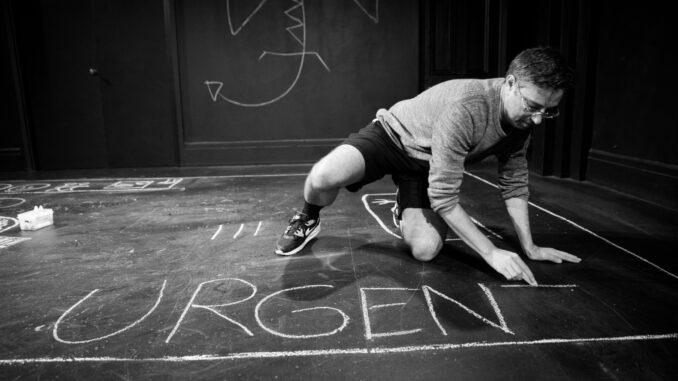
In the same week Auckland Theatre Company and Basement Theatre confirmed they were closing for the rest of the year, I attended a one night-only performance of Back to Square One? at the Tahi Festival of Solo Performance at Wellington’s BATS Theatre.
Back to Square One? is a Covid show, inspired by writer/performer Anders Falstie-Jensen’s conversations with his 95-year-old grandmother Inga during the early stages of the pandemic. The show is partly about Inga’s experience isolated in her home in Denmark, and what it meant to go back to square one after a brush with illness – back to her house, still enduring.
I felt incredibly fortunate to be able to gather in person for this performance. Back to Square One? is a show about connection despite physical distance. In one sequence, the audience is surveyed to find out what how many countries we collectively have close family ties to – our final tally was an impressive 33 distinct countries. Like Inga over in Denmark, people who weren’t able to be physically in the room with us that night felt very present.
This included Anders Falstie-Jensen himself. He was scheduled to tour from Tāmaki Makaurau for the festival, but Delta decided otherwise. In his place was Playmarket’s Salesi Le’ota, who made a heroic effort to learn the show over a handful of Zoom calls. Anders’ script was plastered on the theatre’s walls, just a meaningful pause away should Salesi need to find his place.
This wasn’t the first time another actor had stood in for Anders. Back to Square One? is a Covid show in form as well as content – Anders had made the show so that it could be performed distanced in people’s driveways, as well as allow other actors to step in to play his role.
Anders told me he named the show Back to Square One? because he “saw this pandemic as an opportunity to re-think who we make theatre for, where and why?” The idea “was to make something that could be learnt and staged quickly and performed indoors or outdoors without me being there. It was made for a Covid world where touring wasn’t an option.” The show has already travelled widely – Anders performed it for 200 people in Havelock North, Margaret-Mary Hollins took it to Hamilton Gardens, Phil Vaughan did it a backyard in Dunedin, and Alison Bruce starred in Anders’ own driveway in Auckland. “Ultimately, it’s about giving people a chance to gather (be that 5, 25 of 100) in the real world and experience something together. That’s what the show is made for, and my presence is not necessarily necessary for that to be achieved.”
The show exemplifies the drive from our artistic community to keep going, to innovate, to find ways to connect with and awhi audiences, to share stories and collective joy.
But keeping on going is hard going in the pandemic. As Aotearoa’s Delta outbreak stretches on and we attempt to reconcile what a ‘suppression’ approach to Covid means for us in reality, the path forward for the live arts sector in Aotearoa (we’re talking festivals, music, theatre, dance, comedy, literary events and more) still looks very uncertain.
Despite the coming of vaccine passports and a transition from alert levels into a traffic light system, arts events may continue to face considerable challenges into 2022 – a green light for the full resumption of our live arts may still be a way off.
And after record Government funding of the arts, and after months of lockdowns, the last place we want to find ourselves is back to square one – a vulnerable arts ecology still struggling to survive.
This is the full version of an essay first published by Newsroom. I have written it as a check in – how is the arts sector faring three months into NZ’s Delta outbreak? What are some scenarios that could play out into 2022? And what further support might the arts and culture sector need to ensure we don’t arrive back at square one?
Delta’s National Impact
Auckland, Waikato and Northland have borne the brunt of Delta restrictions, with Auckland spending the longest in alert level 4 and 3. While a shift to the new red light seeing is on the horizon for Tāmaki Makaurau around the start of December, a red light does not offer any immediate relief for Auckland’s arts community. Even though vaccine passes will enable small gatherings, it takes time to get most arts events together and few will be in a position to reopen before Christmas
That means live arts events will have been on ice in New Zealand’s biggest city for a quarter of 2021 (not to mention the short bursts in level 3 earlier in the year). That’s a huge number of cancellations, and behind each cancellation is a team of arts practitioners hurting financially, mentally, and emotionally.
Basement Theatre saw the writing on the black box wall, announcing on 18th October that the venue would be closing down for 2021. Executive Director Cat Ruka explained that the Basement community’s wellbeing was at the forefront of the decision: “Constantly rescheduling show dates based on the drip-feed of information from the government around alert level shifts was starting to become a tiring and disappointing cycle for the artists, and a recipe for burnout for my staff. It was time to jump off that waka and just make a call to press pause so that we can come back stronger than ever next year.”
The same week Auckland Theatre Company announced that it was cancelling the rest of its 2021 season (including a national tour of The Haka Party Incident) – with each cancellation costing an additional several hundred thousand dollars for ATC.
ATC is paying staff and contractors affected by the cancellations, while Basement Theatre is offering a number of initiatives to support affected artists. The Basement has also opened a donation drive to “give directly to our crazy beautiful independent artists…. it could be the cost of the theatre ticket you would have bought, or the congrats drink you would have shouted them post-show. ”
To read more on how the lockdown fallout has impacted theatre in Tāmaki Makaurau, Sam Brooks has the story for The Spinoff.
Reflecting the interconnectedness of our arts ecology, lockdowns in the North of Te Ika-a-Māui affect arts events across the entire country. The Tahi Festival in Te Whanganui-a-Tara is a case in point, which had programmed a number of shows from Tāmaki based artists. Alongside the performer switch from Anders to Salesi in Back to Square One?, two shows became digital works, and one was cancelled. The rest of the festival went on in alert level 2 conditions.
Other arts events across the motu impacted by the Delta outbreak and alert level restrictions include:
- The Whāngarei Fringe – consisting of 134 individual events – was cancelled due to the lockdowns in Auckland, Waikato and Northland.
- The Tauranga Arts Festival cancelled its 10 day festival, with restrictions impacting preparation, marketing, and audience size.
- The Nelson Arts Festival cancelled most of its in person events, but went ahead with some digital sessions.
- WORD Christchurch presented a “revised, downsized, Covid-safe 2021” Festival programme, with 39 cancelled events.
A number of arts events have dug in and gone on in level 2 areas. ‘Sold out’ notices have been popping up with regularity on ticketing pages for events across Wellington (including many sessions at the current Film Festival), but this does not tell the full story. Delta level 2 performances were first capped at 50, then 100, and now, the cap has been removed (although 1m distancing is still in place). This has helped, but many live arts events are still missing out financially by playing below usual capacity due to the distancing rules.
Actors remark at the strangeness of playing to a room full of audience members wearing masks – an unnerving experience because they are unable to see audience’s responses.
When performing Back to Square One?, Salesi commented a few times about what we would have been able to do as audience if we weren’t under level 2 restrictions – including being able to help with chalking the stage floor, or staying for longer after the show for cake and chats.
As an audience member, I am really feeling the absence of serendipitous experiences of connecting with people in the foyers before and after a show. We are in and out of theatre, no lingering, missing a core part of the social arts experience.
Still, I feel grateful that I am in a city where I can still see live performance, even with restrictions. My heart aches for friends and artists in the North.
Funding Needs
When I wrote my last Covid check in for Theatre Scenes in September, the immediate prospects for the arts sector were looking very grim indeed, and I joined the call for the Government to urgently provide targeted support.
43 days after Aotearoa entered level 4 lockdown due to our first Delta community case, Minister for Arts, Culture and Heritage Carmel Sepuloni announced Delta relief funding for the arts and culture sector.
Manatū Taonga Ministry of Arts, Culture and Heritage’s $37.5m package featured:
- $10 million spread around Creative New Zealand, the New Zealand Music Commission, Te Papa/Museums Aotearoa, and the New Zealand Film Commission.
- $5 million for a new Manatū Taonga Cultural Sector Emergency Relief Fund, a fund of “last resort” to support cultural organisations, including sole traders, at clear risk of no longer operating viably.
- $22.5 million “to give the cultural sector confidence to plan and host performances and events over the next 6-8 months given the uncertainty of COVID-19 alert levels.”
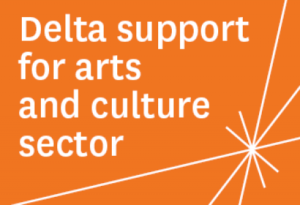 This package has provided critical short-term relief to the sector – particularly the emergency relief fund. Meanwhile, the sector continues to await details about the form the final $22.5 million will take. In Manatū Taonga’s latest update on 18th November, it confirmed the fund will be geared towards event organisers as an “avenue for support should they need to cancel or postpone scheduled events because of COVID-19 restrictions.” Manatū Taonga hosted a workshop this week to work together on the shape of the scheme. This is slow going, but encouraging.
This package has provided critical short-term relief to the sector – particularly the emergency relief fund. Meanwhile, the sector continues to await details about the form the final $22.5 million will take. In Manatū Taonga’s latest update on 18th November, it confirmed the fund will be geared towards event organisers as an “avenue for support should they need to cancel or postpone scheduled events because of COVID-19 restrictions.” Manatū Taonga hosted a workshop this week to work together on the shape of the scheme. This is slow going, but encouraging.
The $37.5 is big money in an arts funding context, but Manatū Taonga’s own figures puts the figure in perspective. The estimated loss of economic activity in the arts and culture sector for the first month of Delta restrictions was $466m. Usually, arts and culture would have generated an estimated $1.08 billion over that period, but this was almost halved to $610m.
$37.5m to try to make up for a loss of close to half a billion dollars.
There are some further areas of need that remain unaddressed by the funding. Community arts groups and venues – a vital conduit for New Zealanders’ participation in the arts – still require help.
In a guest post for Theatre Scenes, Amber Liberté warned that independent arts practitioners are being left out of the Delta support: “CNZ have not given artists the safety net independent artists need right now.”
This is confirmed by the results of an Independent Artists Survey of 543 independent practitioners. 73% had paid work cancelled by Delta. 51% described the financial outlook for the next 6 months as either poor (expecting to make less money than the previous 6 months) or terrible (most or all of projected income wiped out). Only 3% of respondents said they had more than enough work to get by. Anyone else hear those alarm bells?
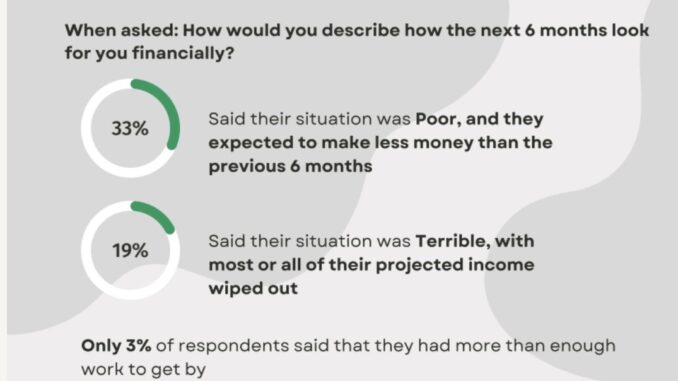
Currently the main avenues for support are the Government’s wage subsidy and resurgence support payments. 63% of respondents had received one or both of these, but 70% of those who had received these payments reported that it was “barely enough, or not enough money to live on.” Worryingly, it seems that the message that practitioners are even eligible for these meagre supports hasn’t one wide enough: of those that didn’t receive the wage subsidy or RSP, 25% were unaware they could even apply.
During last year’s lockdown Creative New Zealand offered arts freelancers top ups to the wage subsidy, spending $10 million. 32% of respondents received this emergency relief grant, of those, 70% said it was important for their financial stability in 2020. However, similar support has not been forthcoming this year.
What about Manatū Taonga’s new Cultural Sector Emergency Relief Fund of $5 million? So far 22 organisations have met eligibility criteria for the support, “helping to protect the jobs of more than 250 people in the cultural sector.” But damningly, of 226 full time practitioners who answered the survey, only 17 were able to fulfil of the fund’s onerous criteria. Half fell at the first hurdle by not having a New Zealand Business Number.

The Independent Artist Survey was led by Johanna Cosgrove, Alice Canton, and Sam Snedden, who saw that advocacy conversations were missing “data on how the pandemic and resulting shutdowns have affected gigging artists and creative workers – contractors who are outside of an organisational structure.” They say the “the results provide a clear picture of a community in the midst of a deep financial and emotional crisis.” The report concludes that “current mechanisms for accessing financial support are insufficient, overly complex and inaccessible for the vast majority of independent artists” and that a high-trust model would have a major positive impact.
The long-term danger of practitioners leaving the arts sector is also starkly expressed in the report: “many established practitioners are leaving the sector and abandoning their artistic careers due to the stress of working under Covid 19 restrictions.” As one artist expressed, “I have essentially exited the industry after 20 years. I cannot maintain a living from my practice any longer.”
Independent practitioners are falling through the safety nets, and we risk losing a generation of artists.
The survey demands an urgent response and rethink from Creative New Zealand and Manatū Taonga.
With its financial reserves having run dry, CNZ had little room to move during the Delta outbreak. CNZ received a $5m boost from the ministry’s Delta package, but that is getting spent up quickly – almost half has already been allocated.
$1m was immediately put into the Annual Arts Grants, which funds significant events or a 12-month programme of activities. 29 out of 36 applications were funded, totaling a $3.7m investment. There were some big wins here, including important Festivals (Nelson Arts Festival, Dunedin Fringe), and artists and companies who have kept holding on with a strong track record (Binge Culture, FCC, Proudly Asian Theatre). While the extra funding resulted in a massive 80% success rate, and will help make 2022 financially viable for the grant recipients, it is important to note that there are strict eligibility criteria – this isn’t open to everyone.
An extra $1.2m next went into Round 2 of the Arts Grants (which has less restrictive eligibility). This funding allowed an additional 28 projects to be funded in this round. In total, 81 out of 200 applicants were funded (a 40% success rate) to a total of $3.7m. This compares to Round 1, which did not have additional funding, where 65 out of 205 applicants were funded (a 31% success rate).
CNZ has made a call to use the money to boost existing funding programmes as a way to get money to artists by funding specific projects.
This does entrench a competitive system of winners and losers, and I think there is a strong case for CNZ to use the remaining Ministry millions to address Delta specific impacts – and for CNZ’s governing body the Arts Council to ask for more money.
As Amber Liberté advocates, “perhaps the relief fund from MCH could have been used as a safety net for the most vulnerable? As the main arts funder in Aotearoa, the need to intervene in this crisis and offer those in need should be a key concern and something that changes almost immediately […]. Independent artists need urgent support that is accessible and doesn’t require them to jump through hoops to get.”
At 9am on Thursday 1 November, MusicHelps announced the Delta Hardship Grant, which offered a $1000 rapid response grant to eligible practitioners in the music industry who have experienced a loss of income as a result of Covid-19 restrictions and cancellations. By 3:40pm that day, applications were temporarily suspended due to the high demand. The grant was organised in association with the New Zealand Music Commission (which had received additional funding from the ministry).
The response to this grant illustrates the need that is out there – and a need that goes beyond the music industry. A similar scheme for all arts workers impacted by Delta would help direct relief to those most in need.
Invest in people now – arts project will follow later.
There are two further important points of commentary to add to this arts funding analysis.
The first is that the $37.5m from Manatū Taonga is not new funding – it is spending that had been brought forward from the existing Arts and Culture COVID Recovery Programme announced in May 2020. While the $37.5m was critically needed now, and this was the most agile way the Government could quickly get funding to the sector, it does mean that we need to keep advocating for new arts funding from the Government to support our longer-term arts recovery.
The $37.5m was diverted from the proposed ‘Showcasing the Regions’ and ‘Untold Stories’ funding streams. As Te Taumata Toi-a-Iwi argue, “these two streams had the potential to support the mahi or communities that have been historically and continuously marginalised.” Delta relief funding should be in addition to, not at the expense of, these kinds of initiatives.
The second point is there is a much bigger story here about the politics of arts and culture funding in Aotearoa. Recent investment in Creative New Zealand is tiny compared to the big pots of money Manatū Taonga is rolling out. Whether intentional or not, the appearance is of a Ministry making a power grab by positioning itself as the big-wig of arts funding by side-lining Creative New Zealand and its other funding organisations.
For all the legitimate critiques that can be directed towards CNZ, CNZ has a mandate for understanding and supporting the needs of the arts sector and has years of experience in doing just that (its origins date back to 1960 and the Queen Elizabeth Arts Council). The arts funding agency’s strength is its team of peer assessors – people from within the arts community that are independent of CNZ that read the applications and report back on the strength of the artistic idea, the viability of the project, and alignment to CNZ’s strategic goals (and yes, there is a robust conflict of interest policy). I’ve seen this process as a peer assessor and the continual refinements made by CNZ behind the scenes. CNZ’s peer assessment process is as close to gold standard as you can get when benchmarked against other international publicly funded arts grants schemes.
Which is why it does not make good sense for Manatū Taonga to quickly set up its own funding infrastructure for the Arts and Culture COVID Recovery Programme separate to existing organisations like CNZ and the Film Commission.
You might remember the recent uproar from the literary community over the $500,000 in funding for Narrative Muse’s book recommendation app as part of Manatū Taonga’s Cultural Sector Innovation Fund. This funding decision was described as “a shocking undermining of the New Zealand books sector” by Massey University Press publisher Nicola Legat. The grant demonstrated just how profoundly out of touch the Ministry is with the book sector.
This is an eye watering amount of money in the usual scale of arts funding resources – Narrative Muse’s funding alone equivalent to 10% of the $5m allocated to CNZ by the Arts Minister in the Delta relief package.
The Cultural Sector Innovation fund was set up to provide $60 million over three years for innovative projects that “that improve the sustainability and resilience of the sector, provide commercial opportunities, and improve access and participation.”
Other recipients look more promising. Māori theatre rangitira Taki Rua productions has received a game changing $1.3m towards the “development and delivery of two immersive live productions of large-scale contemporary Māori performing arts pieces.” Some seed funding projects (20k grants) are similar to what CNZ might usually fund. The projects supported by the Ministry’s Capability Fund also largely correspond with CNZ’s existing remit.
Christian Barton has warned that the Innovation fund “seems like a golden opportunity that is in danger of being squandered.” Barton questions the Ministry’s decision-making process: “they are not visible or active in my world: the world where artists create and show work, exhibitions are made, collections built, audiences cultivated, books published, websites launched, so often for a pittance […] I hope they review their model before the pot is empty. Let’s complement ‘’innovation’’ – that buzzword of neo-liberal thinking – with concepts of ‘’care’’, ‘’maintenance’’ and ‘’repair”.”
Mark Amery has also sounded the alarm: “The ministry, developing a programme and assessment process at pace in 2020, hasn’t had CNZ’s years of building relationships and knowledge. It’s difficult to understand why it isn’t administering this process, especially when so many CNZ-funded artists are also getting ministry funds. […] Is it too late to pause and work out our priorities together?”
Part of the problem is the lack of a larger plan, heightened by the Manatū Taonga’s paucity of engagement with and knowledge of our grassroots arts communities. Te Taumata Toi-a-Iwi note that “we are witnessing substantial funding being allocated without long-term strategic direction.” Te Taumata Toi-a-Iwi continue to call for the development and implementation of a national arts strategy: “there is a window of opportunity to re-think and re-imagine the future of the sector and its infrastructure. The systems are broken, and COVID-19 is playing a major role in revealing that.”
Just imagine what we could do with a national strategy to get behind – an arts led transformation for community connectiveness and national health and wellbeing.
A truly innovative initiative highlighted by Amber Liberté and Mark Amery is Irelands’ three-year pilot trial of a basic guaranteed income for artists.
The top recommendation of the Nov 2020 Arts and Culture Recovery Taskforce’s Life Worth Living, 2000 creative workers will receive a basic income guarantee of NZ $526 per week (equivalent to 30 hours of the Irish minimum wage). Indie rock singer Sarah Corcoran says the scheme “sends a message to artists living and working in Ireland that their work is valued, appreciated and necessary.”
Could we try something similar here?
Nurture ngā tangata, ngā toi will follow.
Getting the Green Light
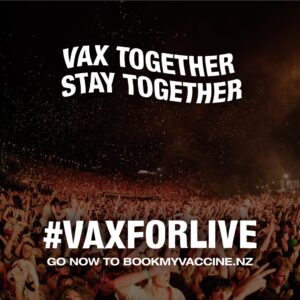 Arts organisations, venues and events promoters throughout the country have joined the #VaxforLive campaign, encouraging New Zealanders to get vaccinated so they can enjoy gigs and arts events over summer and throughout 2022.
Arts organisations, venues and events promoters throughout the country have joined the #VaxforLive campaign, encouraging New Zealanders to get vaccinated so they can enjoy gigs and arts events over summer and throughout 2022.
Under the coming traffic light system, a vaccine certificate will be your ticket for most dance, theatre, music and other live arts experiences.
Local ticketing company iTICKET are even building the Government’s vaccine certificates into its service, so you can pre-verify your vaccine status and jump the venue queue.
A highly vaccinated population offers the greatest hope for resuming live arts across the country in 2022, but examples from overseas show that even with our 90% double vax targets, considerable challenges still lie ahead.
By December, the whole country is set to move into the Covid-19 protection framework aka the traffic light system. This provides some direction for how arts events can expect to operate in the near future.
Vaccine passes are coming – and arts workers and audiences will need to be double vaxed to enjoy most live arts experiences.
This is similar to the requirements for shows on Broadway, New York City – a mandate for audiences to be masked and those aged 12+ to provide proof of full vaccination has recently been extended through February 2022. Those under 12 must now provide proof of at least one dose, or have had a recent negative test.
Most of the areas of the country currently in alert level 2 will start with the orange traffic light. Orange (with certificates) is a better deal for live shows which have faced venue caps under the 1m seated distancing rules of level 2. Importantly, events that don’t use vaccine certificates are not able to operate at all under orange.
Of course, implementing vaccine passports will be a whole other challenge, especially for independent arts events that take place outside of traditional venues. There’s a heap of unanswered questions about how this will operate in practice.
Auckland and less vaccinated parts of the country will start with the red traffic light. Red kicks in when the health system is facing an “unsustainable number of hospitalisations” and action is “needed to protect at-risk populations.” The Red light not only represents a danger zone for our country’s health system, but also our arts and events sectors.
Under the red light setting, both indoor and outdoor events using vaccine passports are allowed “up to 100 people based on 1m distancing, seated and separated” – a stricter threshold than the current level 2 settings. Smaller venues may need to seat fewer than 100 people due to the distancing requirement, while larger venues may not find it viable to open for 100 people, just like what happened in previous level periods when we had a 100 person maximum cap.
The problem for live arts is that even with world-leading vaccination numbers, it is projected that we will still face a high and inequitable Covid case load that would strain our health system and put Māori at particular risk. Te Pūnaha Matatini modeller Shaun Hendy has warned that “we’re not going back to that kind of level 1 life that we’ve enjoyed for most of 2020 and 2021” and that we may spend half to three quarters of the year in a red light setting – “with delta you really can’t go back to normal without putting a lot of people at risk and really overwhelming your healthcare system.”
Localised lockdowns also remain part of the traffic light framework, “and there may still be a need to use wider lockdowns (similar to the measures in Alert Level 3 or 4).”
And then there is the spectre of breakthrough cases. Whilst the science tells us that vaccination substantially reduces our risk of catching and passing on Covid, breakthrough cases of Covid infection is still possible in people who have been vaccinated.
After opening on Broadway after an 18+ month closure, Disney’s stage musical Aladdin closed again the very next night after breakthrough infections were found among vaccinated members of the company.” With guidance from Disney’s own resident epidemiologist, the production eventually paused for two weeks before reopening. Shows in London also faced issued with breakthrough cases and isolation requirements with impacted the West End’s reopening. Live arts practitioners in Aotearoa need to be prepared for these possibilities too.
The traffic light system may not yet be the breakthrough the live arts sector needs to be able to resume performances with confidence in 2022. As CNZ’s Stephen Wainwright acknowledges, “anything other than Alert Level 1 is tough for all whose livelihoods depend on the live arts.”
The arts sector in general is not calling for loser restrictions. Aotearoa has been one of the rare countries in the world that has had fewer deaths than average since Covid emerged. If we need to be in red light (or go to a localised lockdown), let’s do so to protect our whānau. But the arts will continue to need help through this.
Arts practitioners will find it difficult to survive another round of making financial, artistic and emotional investments in work, only to face yet another cancellation when we move into red light or a breakthrough infection emerges in the company.
Following prodding from Act and National, the Government has put in place an insurance scheme that will cover most of the costs if events for 5000+ attendees have to cancel due to Covid restrictions. That’s good news for the likes of summer music festivals and the promoters of the Come from Away musical, set to tour Auckland and Wellington next year. Minister for Small Business Stuart Nash explained that events “incur significant costs in advance. A quick shift in public health measures could see an event cancelled with no opportunity to recoup costs or generate revenue.”
A similar scheme for smaller live arts events would make all the difference – another cancelled event can make or break practitioners’ livelihoods, many of whom, as reflected in the Independent Artists Survey, are facing decisions about whether to stay and tough it out, or leave the industry. Already there are warnings that an “Arts worker shortage could threaten Aotearoa’s Cultural Reputation.”
This is where Manatū Taonga’s $22.5 million to give confidence to the arts sector to plan and host events over the next 6-8 months could really come in handy if we do need to spend most of 2022 in red to protect our people and health system.
As we journey into 2022, we need to be prepared that the green light in the Covid protection framework may be on a very short phase.
We can hope for green, but live arts need to prepare for red.
Moving beyond Square One
After all this, what would it mean for the arts and culture sector if it found itself back at square one? Square one means low wages, a medium income for creative work of $15,000, and a third of creative workers lacking a financial safety net. As Cat Ruka remarks, “severe financial hardship has become so synonymous with being an independent artist that we’ve come to accept it.” Square one means wellbeing challenges, burn out, and artists leaving the sector.
We need to move far beyond square one by investing in arts and culture for a more sustainable industry, to help us through the challenges of the pandemic environment.
The majority of New Zealanders recognise the value of the arts to provide individual and community connection, wellbeing, and meaning. As Colmar Brunton report, “The arts are making a powerful contribution to New Zealanders’ wellbeing, and are helping us get through COVID-19.”
So how do we avoid it? How can we get to the green light?
Creative New Zealand could prioritise funding for vulnerable arts practitioners during all stages of the pandemic.
Manatū Taonga could empower CNZ and its other funding organisations by handing over more of the ministry’s funding to better utilise existing capability and sector knowledge.
Manatū Taonga could set up an underwriting scheme for smaller scale arts events.
The Government could continue to make investments in the sector, guided by a national arts strategy, and develop our own basic guaranteed income for artists.
Arts organisations (festivals, companies, venues) could fully embrace collaboration in 2022 by sharing resources, space, and people – giving freelance artists centre stage.
Arts organisations could also commission and subsidise work for the red light setting.
Next year, let’s make an abundance of intimate arts events that cater for under 100 people at a time.
Through it all, artists will remain nimble. Back to Square One? is next playing at Ōtautahi Tiny Performance Festival. Anders may still not be able to be there, but Salesi will.
Nurture ngā tangata, ngā toi will follow.

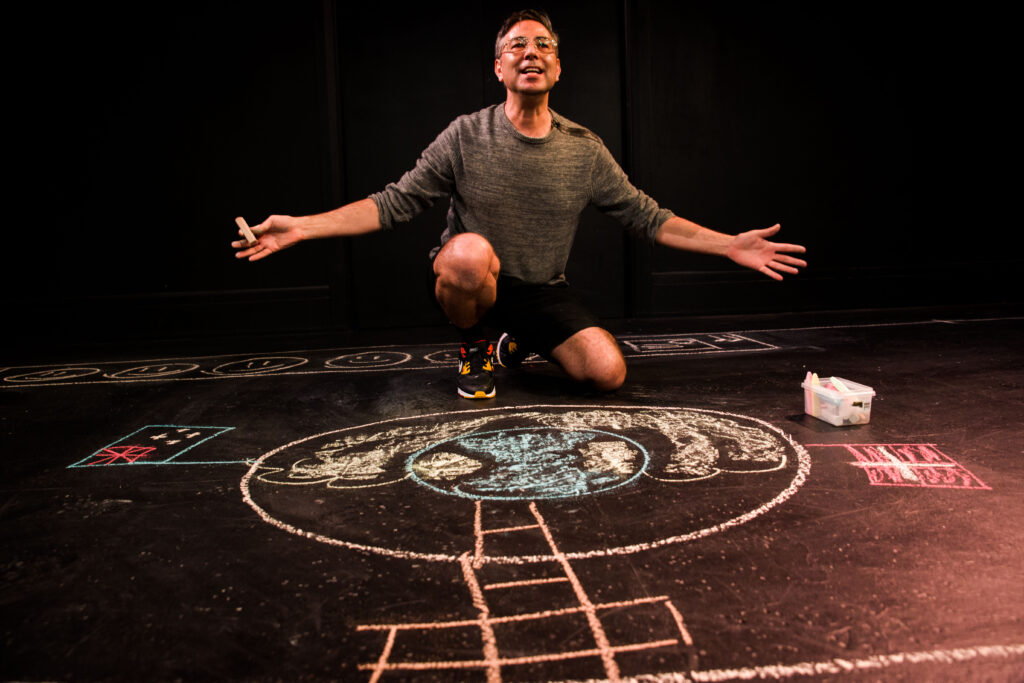
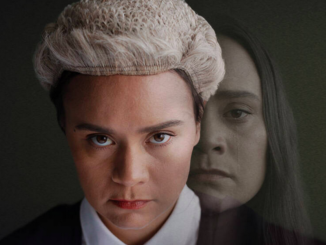
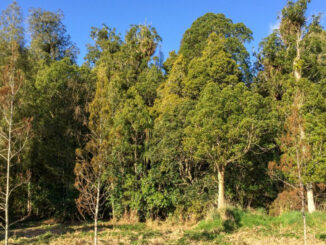
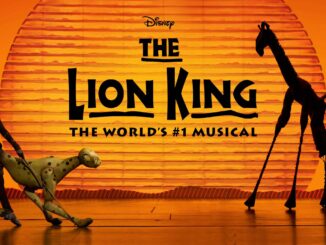
Leave a Reply